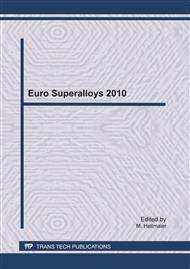p.283
p.289
p.295
p.301
p.306
p.312
p.321
p.327
p.333
Development and Application of Heat-Conductor Technique for Single Crystal Components of Superalloys
Abstract:
During single crystal (SC) solidification in turbine blades of superalloys, grain defects often form in the platform region with abrupt variation in cross-section. In order to reduce grain defects induced by component geometries, a Heat Conductor (HC) technique was developed and applied to the production of SC turbine blades. The corresponding ceramic shell moulds were produced by a modified investment casting procedure. The heat conductors with excellent heat conductivity were inserted close to the inner corners of the platform, to effectively extract the local heat during directional solidification. Both computer simulation and temperature measurements have shown that this technique is able to produce a clear improvement of the thermal condition in the critical region of the components. The SC growth in the blade body can spread into the platform more quickly before the melt at the extremity becomes deeply undercooled. Microstructure investigations reveal a remarkable reduction in grain defect formation, providing confirmation of the effectiveness of the HC technique in improving the casting quality of SC components.
Info:
Periodical:
Pages:
306-311
Citation:
Online since:
July 2011
Authors:
Keywords:
Permissions:
Share:
Citation:


